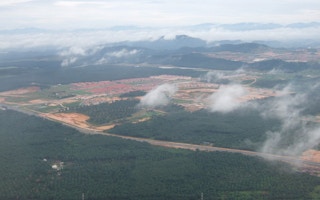A new web monitoring platform aims to achieve full traceability in palm oil supply chains and help companies to meet their zero-deforestation commitments — a goal that continues to elude the industry due to numerous challenges.
Palm oil is a major driver of deforestation in the two countries that produce nearly 90 per cent of the global supply, Indonesia and Malaysia, and whose forests are home to key biodiversity areas.
A 2019 study shows that land clearing for oil palm plantations was the single largest driver of deforestation in Indonesia between 2001 and 2016, accounting for 23 per cent of total deforestation.
One of the keys in stopping oil palm-driven deforestation is the ability to trace the palm oil product back to its origin, making sure that it’s legally sourced and produced from an environmental and social conflict-free area. Known as full traceability, this is a degree of transparency that the industry still hasn’t been able to achieve, despite the efforts of bodies like the Roundtable on Sustainable Palm Oil (RSPO).
“The goal is to make Palmoil.io a self-sustaining and reliable resource for palm oil professionals to identify and mitigate risks in their supply chain,” Leo Bottrill, CEO and founder of MapHubs, told Mongabay.
Monitoring palm oil supply chains has long been challenging due to their complexity. A ton of palm oil derivative like stearic acid, for instance, used widely in detergents and cosmetics, is likely to consist of palm oil from hundreds of mills that, in turn, process palm fruit grown by thousands of plantations.
These webs of plantations and mills make it difficult for companies to fully know where they source from, right down to the plantation level, and thus to provide evidence of compliance. This also makes companies interdependent on each other for ensuring transparency.
So even if efforts have been made to monitor palm oil supply chains, they remain fragmented, expensive, and uneven, according to Bottrill. And without full traceability, a buying company can’t truly know if its palm oil is deforestation-free or not, even if it has made efforts to establish this, such as by publishing a list of the mills it buys from.
“Just because you publish a mill list, purchase RSPO-certified palm oil, and maintain a grievance tracker, doesn’t automatically mean you get a good rating,” Bottrill said. “There is still work to be done.”
Palmoil.io aims to rectify this by being the first monitoring system that reflect the reality of shared supply chains in the industry. To do that, the platform collects various data, including mapping data such as concession boundaries and mill locations, supply chain information from public mill lists, land classification maps, reliable and free forest alert technology, and widely available satellite imagery.
Palmoil.io analyses more than 2,000 palm mills, 480 refineries and crushers, and 400 high-risk plantations. It also screens all major palm oil traders, buyers and suppliers.
By analysing such a large number of mills and identifying forest loss within a 25-kilometer (16-mile) radius of mills, Palmoil.io is able to identify not only whether deforestation has occurred or not, but also what and who caused it.
“We rate each mill on both the amount of recent deforestation as well as historical deforestation and future risk,” Bottrill said.
Besides deforestation, Palmoil.io also tracks mills and suppliers associated with human rights and labor violations, by building a common grievance database featuring more than 1,400 grievances that are updated monthly. Having this database means individual companies don’t have to maintain their own grievance trackers.
With all this data, Palmoil.io can identify high-risk mills and inform subscribers to the platform not only about their exposure to the mills, but also about other companies that buy from the same mills. As a result, companies that share the same exposure to high-risk mills can work together to address the issues — essentially, buyers putting pressure on their common vendors.
“Palmoil.io shows where you need to improve, and perhaps most importantly, allows you to compare your performance with your peers,” Bottrill said. “Peer pressure might be the most powerful tool we have to achieve this zero-deforestation goal.”
Since its launch earlier this year, Palmoil.io has been used by major traders and buyers like Golden Agri Resources (GAR), Pacific Interlink, Olam and BASF.
In April, Palmoil.io notified major traders and buyers that subscribe to the platform that they’re exposed to deforestation as they’re buying from high-risk mills in Peninsular Malaysia, before the deforestation risks had been widely reported.
Bottrill said the Palmoil.io team would continue updating and improving the platform by adding more mills into the database. An upcoming feature will be plantation ratings.
“Similar to mills, this will be a list of concessions that will be rated for recent, historical and future deforestation risk,” Bottrill said. “We will also identify buyers and the grievances associated with that concession and group owner.”
MapHubs is also developing an experimental approach to analysing deforestation risk from smallholders, since very few of them have been mapped despite accounting for 40 per cent of all palm oil production.
“Despite the many challenges, I’m optimistic palm oil could be the first major deforestation-causing commodity to move definitively towards a deforestation-free mode of production,” Bottrill said. “Palmoil.io’s job is to help accelerate the ‘could.’”
But for palm oil to be truly deforestation free, he added, it’s important for all stakeholders to be involved.
“This is not about delivering a sustainable supply chain for one particular company or market. This is about everyone,” Bottrill said. “There can’t be a sustainable market and a leakage market — there can only be one market. So whether you are selling Snickers bars to Slovenians or cooking oil to Indians, sustainability must become an industry standard, not some voluntary luxury. We want Palmoil.io to play an important role towards achieving this.”
This story was published with permission from Mongabay.com.










